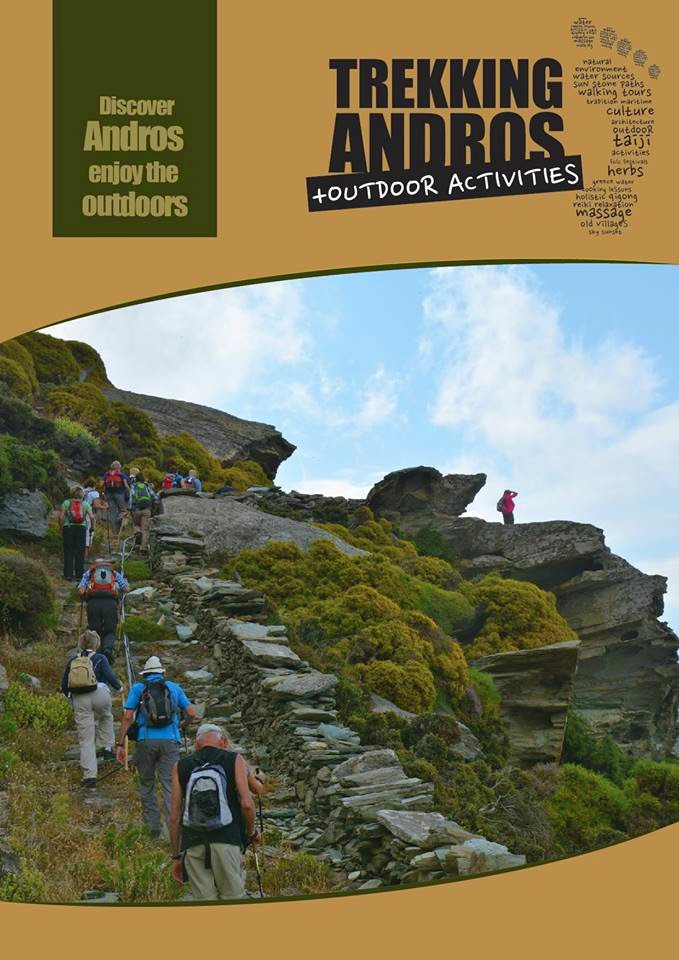Η Ζαγορά της Άνδρου αποτελεί έναν από τους σημαντικότερους
τόπους για τη μελέτη της Γεωμετρικής περιόδου στο νησιωτικό χώρο
 Για 3η συνεχή χρονιά από 2012 και μετά απο 40
χρόνια των πρώτων ανασκαφών (τέλη 1960-αρχές 1970 από το Αλέξανδρο Καμπίτογλου)
αυστραλοί αρχαιολόγοι (Αυστραλιανό Αρχαιολογικό Ινστιτούτο Αθηνών, το
Πανεπιστημίου του Σίδνεϊ και το Αυστραλιανό Συμβουλίο Ερευνών.) βρίσκονται στο
τέλος των φετεινών ανασκαφών τους.
Για 3η συνεχή χρονιά από 2012 και μετά απο 40
χρόνια των πρώτων ανασκαφών (τέλη 1960-αρχές 1970 από το Αλέξανδρο Καμπίτογλου)
αυστραλοί αρχαιολόγοι (Αυστραλιανό Αρχαιολογικό Ινστιτούτο Αθηνών, το
Πανεπιστημίου του Σίδνεϊ και το Αυστραλιανό Συμβουλίο Ερευνών.) βρίσκονται στο
τέλος των φετεινών ανασκαφών τους.
 Την Πέμπτη 6 Νοεβρίου
στις 19.00 και στο Κινηματοθέατρο της Χώρα, υπεύθυνοι, θα μας παρουσιάσουν για μια τελευταία φορά
πριν αναχωρήσουν από το νησί, ευρήματα της ανασκαφής τους.
Την Πέμπτη 6 Νοεβρίου
στις 19.00 και στο Κινηματοθέατρο της Χώρα, υπεύθυνοι, θα μας παρουσιάσουν για μια τελευταία φορά
πριν αναχωρήσουν από το νησί, ευρήματα της ανασκαφής τους.
Zagora remains the most extensively preserved settlement in the central Aegean DATING to the 8th century BC.
 The people
of Zagora left around 700 BCE. Zagora is like a snapshot in time. Many other archaeological sites have been
ruined by earthquakes, volcanic eruptions or the ravages of war. Or their
architecture and artefacts portray a less clear picture due to successive
periods of habitation by different peoples, obscuring or confusing the evidence
of earlier habitation. The settlement layout at Zagora – over 6.7 hectares –
was not disturbed by subsequent settlement.
The people
of Zagora left around 700 BCE. Zagora is like a snapshot in time. Many other archaeological sites have been
ruined by earthquakes, volcanic eruptions or the ravages of war. Or their
architecture and artefacts portray a less clear picture due to successive
periods of habitation by different peoples, obscuring or confusing the evidence
of earlier habitation. The settlement layout at Zagora – over 6.7 hectares –
was not disturbed by subsequent settlement.
Photos from
the visit of the archaeological site, after an invitation to a guided tour, to all
people living in or staying on Andros on Saturday 25 October 2014. The tour was
led by the directors of the project, Professor Meg Miller and Associate
Professor Lesley Beaumont (both from the University of Sydney) and Dr Stavros
Paspalas (Deputy Director of the Australian Archaeological Institute at
Athens). The event was organized by Andros Routes.
Ο οικισμός της Ζαγοράς άκμασε κατά τη Γεωμετρική περίοδο
(10ος-8ος αι. π.Χ.). Το ισχυρό τείχος, η εντυπωσιακή πύλη, τα σπίτια, καθώς και
το τέμενος με το μεταγενέστερο ναό αποτελεί ένα σημαντικότερα μνημεία της
Γεωμετρικής εποχής στον ελλαδικό χώρο.
 Για 3η συνεχή χρονιά από 2012 και μετά απο 40
χρόνια των πρώτων ανασκαφών (τέλη 1960-αρχές 1970 από το Αλέξανδρο Καμπίτογλου)
αυστραλοί αρχαιολόγοι (Αυστραλιανό Αρχαιολογικό Ινστιτούτο Αθηνών, το
Πανεπιστημίου του Σίδνεϊ και το Αυστραλιανό Συμβουλίο Ερευνών.) βρίσκονται στο
τέλος των φετεινών ανασκαφών τους.
Για 3η συνεχή χρονιά από 2012 και μετά απο 40
χρόνια των πρώτων ανασκαφών (τέλη 1960-αρχές 1970 από το Αλέξανδρο Καμπίτογλου)
αυστραλοί αρχαιολόγοι (Αυστραλιανό Αρχαιολογικό Ινστιτούτο Αθηνών, το
Πανεπιστημίου του Σίδνεϊ και το Αυστραλιανό Συμβουλίο Ερευνών.) βρίσκονται στο
τέλος των φετεινών ανασκαφών τους.
Βρεθήκαμε σε μία ανοιχτή ξενάγηση -πρόσκληση προς όλους τους ανδριώτες και μη, από τους υπεύθυνους αρχαιολόγους προκειμένου να
ενημερωθούμε για τα καινούργια ευρήματα και την εξέλιξη της ανασκαφής.
Η
ξενάγηση έγινε σε ομάδες από τους Καθ. Meg Miller και Lesley Beaumont από το Πανεπιστήμιο του Σίδνευ και τον Αναπληρωτή Διευθυντή
του Αυστραλιανού Αρχαιολογικού Ινστιτούτου στην Αθήνα. Δρ. Σταύρο Πασπαλά.
Η πεζοπορία προς τον αρχαιολογικό χώρο έγινε συνοδεία μελών της ομάδας Andros Routes.
 Την Πέμπτη 6 Νοεβρίου
στις 19.00 και στο Κινηματοθέατρο της Χώρα, υπεύθυνοι, θα μας παρουσιάσουν για μια τελευταία φορά
πριν αναχωρήσουν από το νησί, ευρήματα της ανασκαφής τους.
Την Πέμπτη 6 Νοεβρίου
στις 19.00 και στο Κινηματοθέατρο της Χώρα, υπεύθυνοι, θα μας παρουσιάσουν για μια τελευταία φορά
πριν αναχωρήσουν από το νησί, ευρήματα της ανασκαφής τους.
Διαβάστε σχετικά :
Περισσότερες πληροφορίες για την εξέλιξη των ανασκαφών μέσα
από το blog της ομάδας :
http://www.powerhousemuseum.com/zagora/category/zagora-dig-blog/page/2/
Zagora remains the most extensively preserved settlement in the central Aegean DATING to the 8th century BC.
 The people
of Zagora left around 700 BCE. Zagora is like a snapshot in time. Many other archaeological sites have been
ruined by earthquakes, volcanic eruptions or the ravages of war. Or their
architecture and artefacts portray a less clear picture due to successive
periods of habitation by different peoples, obscuring or confusing the evidence
of earlier habitation. The settlement layout at Zagora – over 6.7 hectares –
was not disturbed by subsequent settlement.
The people
of Zagora left around 700 BCE. Zagora is like a snapshot in time. Many other archaeological sites have been
ruined by earthquakes, volcanic eruptions or the ravages of war. Or their
architecture and artefacts portray a less clear picture due to successive
periods of habitation by different peoples, obscuring or confusing the evidence
of earlier habitation. The settlement layout at Zagora – over 6.7 hectares –
was not disturbed by subsequent settlement.
The building materials weren’t used
to modify the buildings or moved to make different structures with them, as is
often the case where there have been successive settlements. …… the buildings
collapsed where they had stood. But the building layout remains, along with
objects and object pieces – mostly pottery, in the rooms where they had been
stored and used. This provides clear evidence of how life was lived at Zagora –
which is extremely rare among central Aegean Early Iron Age sites. Much has
been discovered even though only 10% of the site has been excavated – revealing
55 stone-built rooms. …..















0 σχόλια:
Δημοσίευση σχολίου